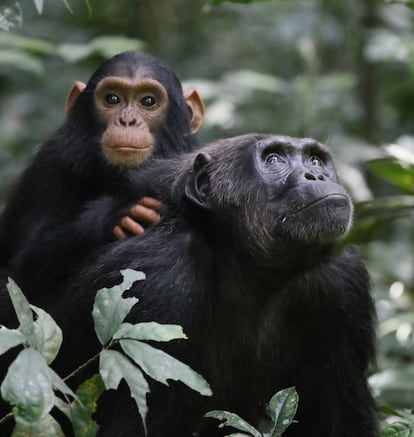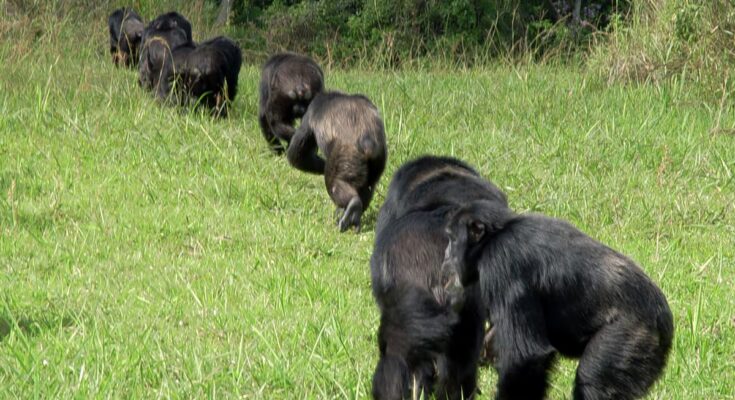For a decade, a community of chimpanzees in Kibali National Park (Uganda) has been waging a series of wars with their neighbors. One of them was completely annihilated, male, female and newborn. They maintained their territory, expanding it by 22%. Studying the conflict in detail, researchers now see that, after emerging victorious, the females in the group doubled their fertility rate. Not only that, as detailed in the scientific journal PNASthe chances of survival of their offspring were multiplied by five. For this community, violence to the point of death of others is an evolutionary strategy that guarantees its survival.
The Ngogo community, protagonist of this story, is the largest of all those in Kibali. Until its division in two, which caused a sort of civil war in 2018, it numbered around 200 individuals. Some of the authors of this research have been studying it for three decades. Two years ago, a highly impactful work on this group was published: like humans, their females also go through menopause. They now show that their fertility rate has more than doubled after they wiped out the other group and took their territory. The war against the neighbors happened between 1998 and 2008. What they saw was that in the three years before the conquest there were 15 births in the Ngogo group. But over the next three years, 37 new calves were born.
“The fertility rate more than doubled in the post-expansion period,” Brian Wood, of the anthropology department at the University of California at Los Angeles (US) and lead author of the study, said in an email. They checked the total number of females of reproductive age before and after to rule out whether an increase in their population was explaining the higher number of births. “Our findings provide the first direct evidence linking cooperative killing between groups with territorial gain and greater reproductive success in chimpanzees,” says Wood.
Even more interesting is the survival rate of the offspring. Among primates, not just chimpanzees, infant mortality is very high. Malnutrition, infections, the violent death of the mother or infanticide within or outside the group mean that a good part of those born do not reach the age of three. In lowland gorillas, for example, when a male dethrones the dominant silverback, the first thing he does is kill the smaller ones in the group. In this way it achieves a triple objective: it interrupts the continuity of the lineage of the defeated, guarantees the perpetuation of its genes and, above all, guarantees that breastfeeding females ovulate and reproduce again.
In the Ngogo community, before the war, before destroying a group of neighbors and before taking over their territory, that is, their resources, the mortality of children before reaching the age of three was 41%. In the post-war period, coinciding with the territorial conquest, the percentage of infant deaths dropped to 8%. Most of the previous deaths were cases of infanticide, mostly by outgroup aggressors. After the war, the risk of external incursion and the likelihood of a calf mistakenly entering enemy territory reduced, as did violence with or towards neighboring groups.
The increase in female fertility and the decrease in the mortality rate are doubly connected, the second affects the first. As mentioned, when a mother loses her calf, her ovarian cycle begins again. This implies that in the Ngogo community the improvement in fertility is not due to a shortening of the interval between births caused by the death of children, but is a direct consequence of the victory in the war.
Chimpanzees are territorial; periodically the males, sometimes accompanied by the females, come out to monitor the borders. And alas, for the other species found in their territory. Primatologist at the University of St Andrews (UK), Josep Call, who was not involved in this study, describes these patrols in detail. “The group becomes stealthy when it borders their territory. Unlike other species, they don’t use olfactory signals to signal it, they just know it,” he says. If they find strangers, the first thing they do is an assessment of their numbers. “Several studies have shown how they behave, if there are two or three on patrol and they encounter a group that outnumbers them, they retreat, but if there are six or more and the others fewer, they attack them, beat them, dismember them and kill them, it’s something brutal,” explains Call.
This brutality has earned the Ngogo community 22% more space, increasing its food resources in the same proportion. This had a double consequence that favored the reproductive success of the group: the females, which suffer from nutritional stress during pregnancy and breastfeeding, had extra resources that also reduced competition with other females for access to them. “These findings help us understand why chimpanzees, and perhaps our early ancestors, evolved the capacity for coordinated violence. When food is scarce, territorial gains can translate into real reproductive advantages,” Wood says in a statement.

There are factors that would indicate the particular bellicosity of the Ngogo community. Perhaps the most relevant is, as primatologist Call recalls, that “in addition to being a very large group, from the beginning when they began to study them they realized that there were many males, more than any other group”. More males mean more tension, but also more effectiveness in patrolling the territory and, if necessary, as has happened, waging all-out war with neighboring groups.
University of Michigan anthropologist John Mitani has studied the Ngogo community for more than three decades and is the senior author of this war study. “Reproduction is central to the evolutionary process, and chimpanzees, like all other animals, are governed by this process,” he recalls in an email. Evolution favors individuals who survive and reproduce more due to the hereditary differences that exist between them. Therefore, Mitani continues, “from a biological point of view, the fact that chimpanzees kill their neighbors, gain territory and, consequently, improve their reproductive capacity, is rational from the point of view of evolution.” However, he concludes, “it is questionable whether chimpanzees actively make decisions on these issues.”
His colleague Call and a large group of researchers who study cognition in primates published a work on the rationality of chimpanzees a few weeks ago. It was a different community, but Call wants to make a difference. “This is a different type of rationality than the one we talked about two or three weeks ago. In this case it is biological rationality. It is simply a question of natural selection,” he emphasizes. In line with what Mitani stated above, the Spanish primatologist recalls that “individuals who do this, if they obtain an advantage in terms of biological and reproductive efficiency, are the ones who will continue to do so; and what they show in this work is that there is an advantage in terms of reproduction”, explains Call.
Scientists who study primates dislike the term chimpanzee warfare, preferring to use more sanitized phrases, such as intergroup violence. For them, war has a profound human connotation, but there are also objective differences. “The lethal intergroup aggression we observe in chimpanzees is similar to the small-scale raids and aggressions that occur in humans living in traditional societies,” Mitani acknowledges in an email. But he quickly adds: “What happens in chimpanzees is different from the type of large-scale warfare that currently occurs among modern humans; the latter can involve thousands of combatants, who do not necessarily live in the same group.” Meanwhile, chimpanzees fight with neighbors only for their resources.



